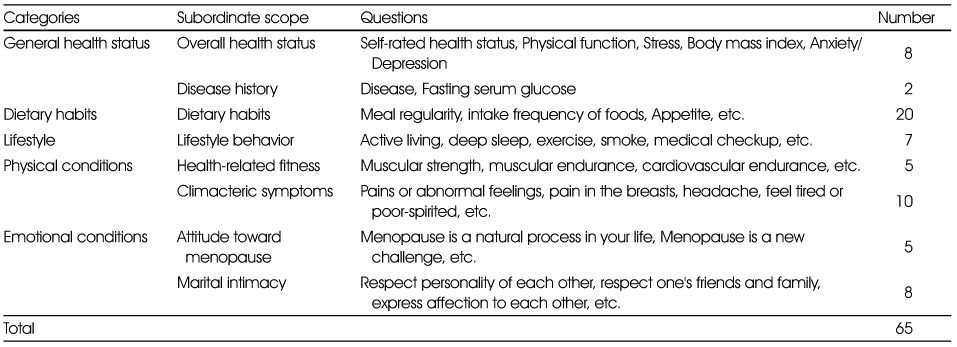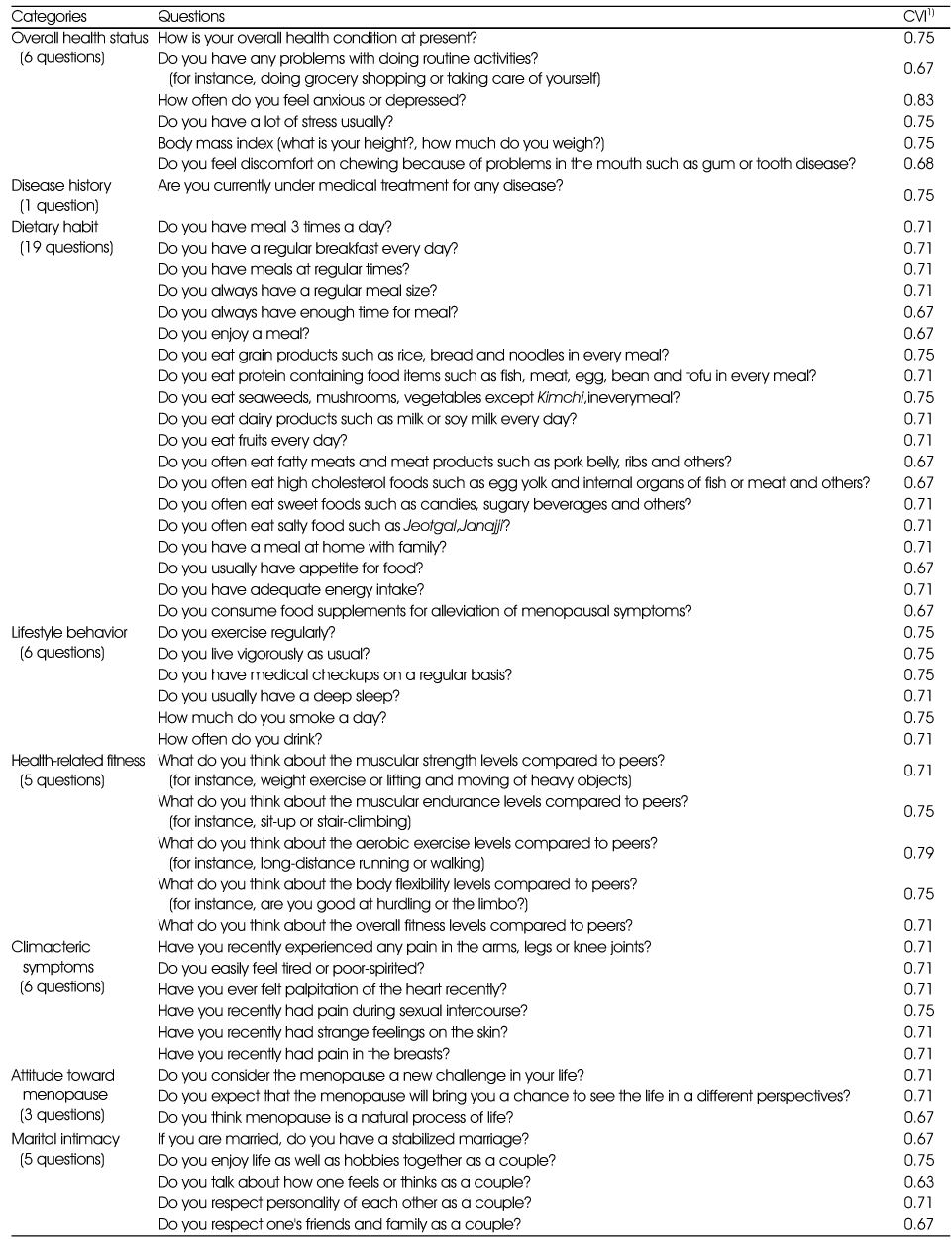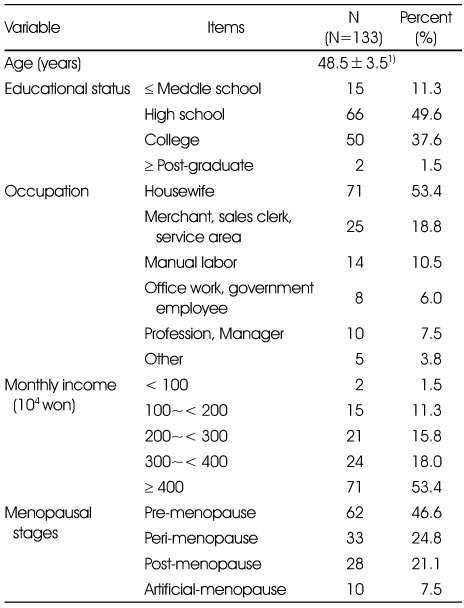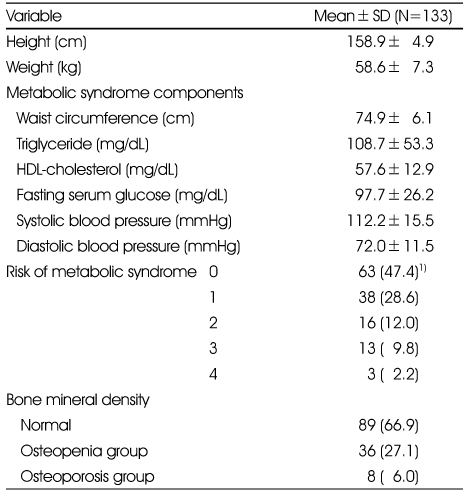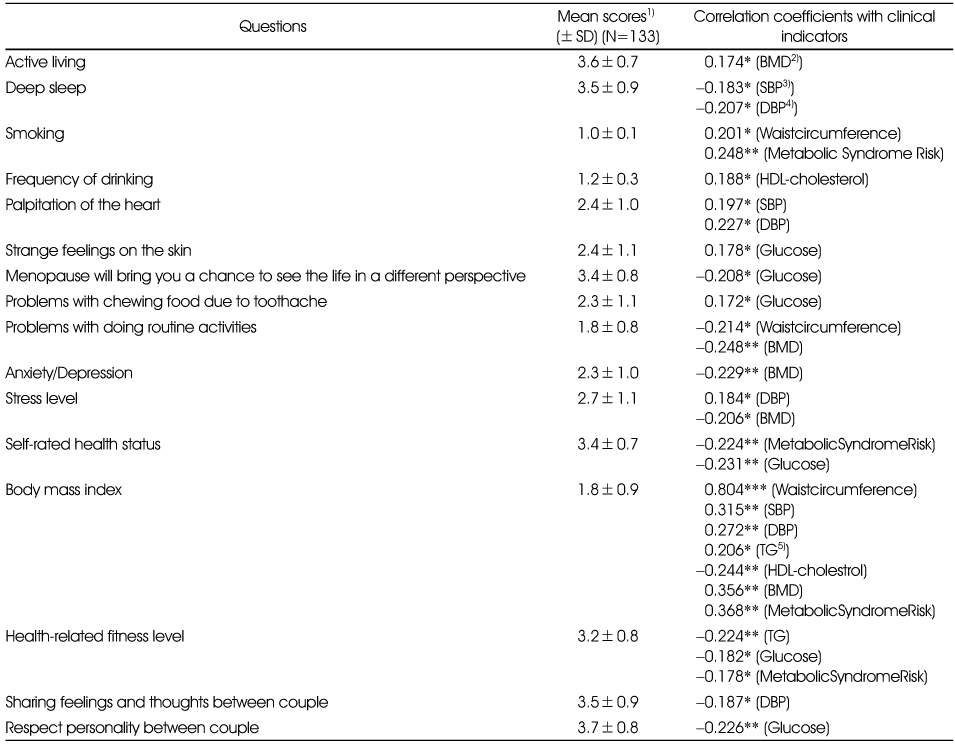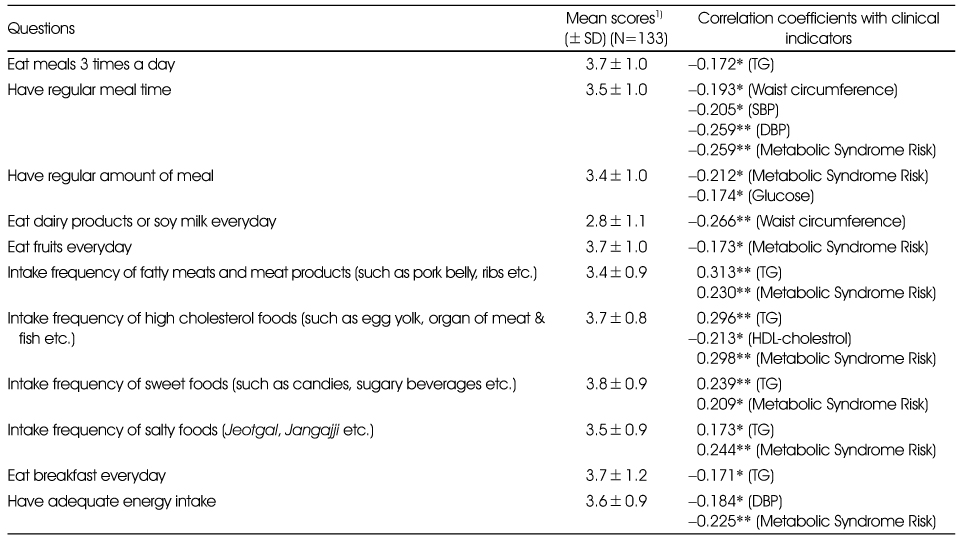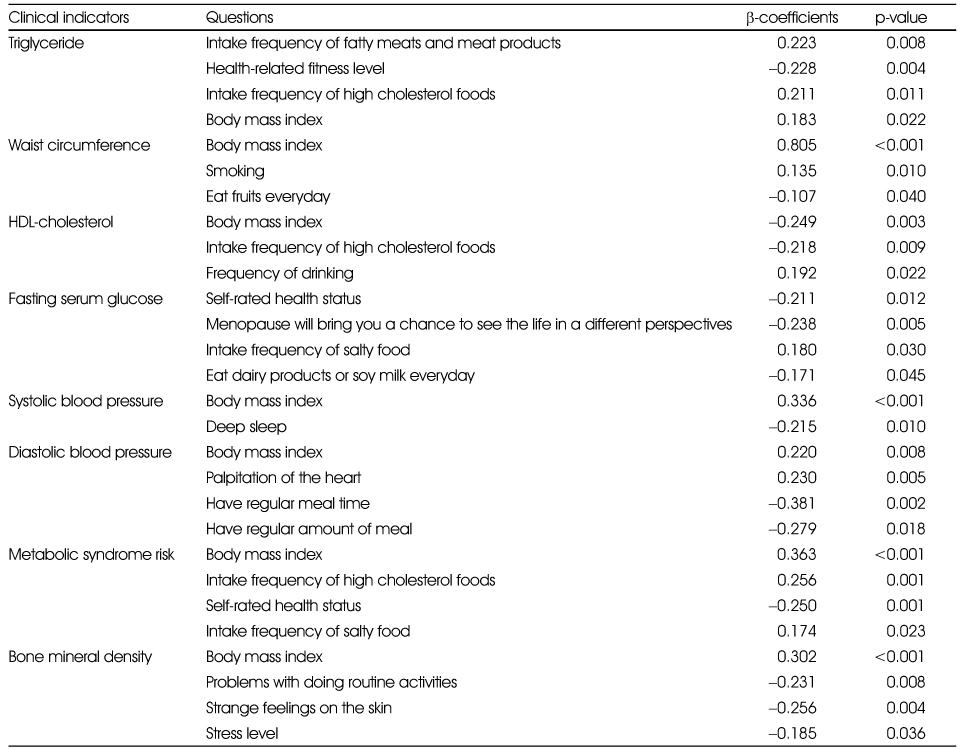References
1. Song AR. Health factors related to management of menopause among climacteric women. Korean J Women Health Nurs 2005;11(1):12–19.
3. Lee YH, Choi SJ. A study of factors influencing health perception in the elderly. J Korean Acad Nurs 2000;30(4):880–892.
4. Yeun EJ. A study on the health promoting lifestyle practices of middle-aged women in Korea. J Korean Soc Health Educ Promot 2000;17(1):41–59.
5. Jung J, Kim N. Risk factors, subjective symptoms, knowledge of coronary artery disease and preventive health practices in postmenopausal women. Korean J Women Health Nurs 2006;12(1):29–36.
6. Kim NS, Song HJ. Women's chronic diseases and policy implications in Korea. Health Welf Policy Forum 2004;93:39–46.
7. Lee HS, Kim CM. Menopausal symptoms and depression among midlife women. J Korean Acad Community Health Nurs 2010;21(4):429–438.
8. Shin HS, Song YA. Effects of koryo hand therapy on menopausal symptoms and blood lipid levels in middle-aged women. Korean J Women Health Nurs 2006;12(4):291–300.
9. Park GJ. Factors influencing the meaning of life for middle-aged women. Korean J Women Health Nurs 2002;8(2):232–243.
10. Lee JE, Park PW, Hyun KS. The relationship between fatigue, stress resistance and emotion in Korean middle aged women. J Korea Acad Ind Coop Soc 2011;12(3):1145–1150.
11. Gu HJ, Eun Y. Concept analysis of middle-aged women's seogeulpeum. Korean J Women Health Nurs 2010;16(4):381–389.
12. Jun SJ, Kim HK, Lee SM, Kim SA. Factors influencing middle-aged women's depression. J Korean Acad Community Health Nurs 2004;15(2):266–276.
13. Yoo JS, Park JW, Lee SJ. A meta analysis on the effects of exercise on bone mineral density among middle-aged and older women. J Korean Acad Community Health Nurs 2009;20(3):285–295.
14. Jeong GH, Yang SO, Lee KO, Pye OJ, Lee MR, Baik SH. Bone mineral density, health-promoting behaviors, and self-efficacy in middle-aged women. Korean J Women Health Nurs 2003;9(2):170–178.
15. Kim IH. The effects of exercise therapy and exercise-behavior modification therapy on obesity, blood lipids, and self-esteem of the obese middle-aged women. J Korean Acad Nurs 2002;32(6):844–854.
16. Park HS, Cho GY, Park KY. The effect of an integrated healthpromotion program in middle-aged women. Korean J Women Health Nurs 2004;10(2):136–143.
17. Lee EH, Choi SS, So AY. Health educational program for women's health in women's health care center. Korean J Women Health Nurs 2000;6(1):61–81.
18. Kant AK, Schatzkin A, Ziegler RG. Dietary diversity and subsequent cause-specific mortality in the NHANES I epidemiologic follow-up study. J Am Coll Nutr 1995;14(3):233–238.
19. Drewnowski A, Henderson SA, Shore AB, Fischler C, Preziosi P, Hercberg S. Diet quality and dietary diversity in France: implications for the French paradox. J Am Diet Assoc 1996;96(7):663–669.
20. Lee O, Kim J, Lee H, Choue R. Nutritional status, quality of diet and quality of life in postmenopausal women with mild climacteric symptoms based on food group intake patterns. Korean J Community Nutr 2012;17(1):69–80.
21. Kim SK, Sunwoo JG. The analysis of the dietary factors related to climacteric symptoms in middle-aged women. Korean J Community Nutr 2007;12(1):25–39.
22. Cho BL, Son KY, Oh BJ, Kim SJ, Kwon IS, Park BJ. Development and validity and reliability of Korean comprehensive assessment tools for geriatric ambulatory care. J Korean Geriatr Soc 2013;17(1):18–27.
23. Ware JE, Sherbourne CD. The MOS 36-Item short-form health survey (SF-36). Med Care 1992;30(6):473–483.
24. Bergner M, Bobbitt R, Kressel S, Pollard WE, Gilson B, Morris J. The sickness impact profile: Conceptual formulation and methodology for the development of a health status measure. Int J health serv 1976;6(3):393–415.
25. Hunt SM, McKenna SP, McEwen J, Williams J, Papp E. The Nottingham health profile: Subjective health status and medical consultations. Soc Sci Med A 1981;15(3):221–229.
26. EuroQol Group. EuroQol-a new facility for the measurement of health-related quality of life. Health Policy 1990;16(3):199–208.
27. Nelson E, Wasson J, Kirk J, Keller A, Clark D, Dietrich A. Assessment of function in routine clinical practice: description of the coop chart method and preliminary findings. J Chron Dis 1987;40(1):55S–63S.
28. Lee H, Lee KH, Kim EK, Kim MJ, Hwang SM. The related factors influencing on self-rated health level of middle-aged women. Korean J Community Nutr 2012;17(3):290–301.
29. Levesque J, Lamarche B. The metabolic syndrome: definitions, prevalence and management. J Nutrigenet Nutrigenomics 2008;1(3):100–118.
30. Mottillo S, Filion KB, Genest J, Joseph L, Pilote L, Poirier P. The metabolic syndrome and cardiovascular risk a systematic review and meta-analysis. J Am Coll Cardiol 2010;56(14):1113–1132.
31. Isomaa B, Almgren P, Tuomi T, Forsen B, Lahti K, Nissen M. Cardiovascular morbidity and mortality associated with the metabolic syndrome. Diabetes Care 2001;24(4):683–689.
32. Hu G, Qiao Q, Tuomilehto J, Balkau B, Borch-Johnsen K, Pyorala K. Prevalence of the metabolic syndrome and its relation to all-cause and cardiovascular mortality in nondiabetic European men and women. Arch Intern Med 2004;164(10):1066–1076.
33. Lee HY, Choi SM. Metabolic syndrome and bone mineral density among elderly Korean women. J Korean Biol Nurs Sci 2011;13(2):134–141.
34. Jeon SK, Hong HR, Yi KW, Park HT, Shin JH, Lee NW. Relationship between metabolic syndrome and bone mineral density in middle-aged women. J Korean Soc Menopause 2010;16(3):142–147.
35. National Cholesterol Education Program (NCEP) Expert Panel on Detection, Evaluation, and Treatment of High Blood Cholesterol in Adults (Adult Treatment Panel III). Third report of the national cholesterol education program (NCEP) expert panel on detection, evaluation, and treatment of high blood cholesterol in adults (Adult Treatment Panel III). Circulation 2002. 106(25)p. 3143–3421.
36. Mueller C. The A.S.P.E.N. adult nutrition support core curriculum 2nd edth ed. American Society for Parenteral Enteral Nutrition; 2012. p. 584.
37. Ministry of Health and Welfare, Korea Centers for Disease Control and Prevention. Korea Health Statistics 2012 Korea National Health and Nutrition Examination Survey (KNHANES) [Internet] Korea Centers for Disease Control and Prevention; 2012. cited 2014 Mar 12. Available from:
http://knhanes.cdc.go.kr/.
38. Park MH. Factors influencing related health promoting life-style in middle-aged women. J Korean Acad Womens Health Nurs 1997;3(2):139–157.
39. Colditz GA, Atwood KA, Emmons K, Monson RR, Willett WC, Trichopoulos D. Harvard report on cancer prevention volume 4: Harvard cancer risk index. Cancer Causes Control 2000;11(6):477–488.
40. Yoo JS, Chang SJ, Choi EK, Park JW. Development of a stress scale for Korean nursing students. J Korean Acad Nurs 2008;38(3):410–419.
41. Lee EH, Tahk SJ, Shin JH, Lee YW, Song RY. Development and psychometric evaluation of cardiovascular disease-specific quality of life scale for Koreans. J Korean Acad Nurs 2007;37(3):313–323.
42. Hwang HS, Kwon IS, Park BJ, Cho BL, Yoon JL, Won CW. The validity and reliability of Korean frailty index. J Korean Geriatr 2010;14(4):191–202.
43. Chung SE. A study of tool development for powerlessness of elderly and the degree of elderly's powerlessness. J Korean Acad Nurs 1999;29(6):1294–1303.
44. Tafreshi MZ, Yaghmaei F. Factor analysis of construct validity: A review of nursing articles. J Med Educ 2006;10(1):19–26.
45. Shin HS, Hyun MS, Ku MOP, Cho MO, Kim SY, Jeong JS. Analysis of research papers published in the journal of the Korean academy of nursing-focused on research trends, intervention studies, and level of evidence in the research. J Korean Acad Nurs 2010;40(1):139–149.
46. Oh SH, Kim BJ. New concept of validity for psychological assessment instruments and its usage. Korean J Sport Psychol 2002;13(3):111–126.
47. Kang H. A guide on the use of factor analysis in the assessment of construct validity. J Korean Acad Nurs 2013;43(5):587–594.
48. Kim HH, Kim JW, Heo JH, Kim DY, Sung SJ. Content validity of aphasia screening test protocol. Korean J Commun Disord 2008;13(3):353–380.
49. Fehring RJ. Methods to validate nursing diagnoses. Heart Lung 1987;16(6 Pt 1):625–629.
50. Han JS, Lee SM, Chung HK, Ahn HS, Lee SM. Development and evaluation of a nutritional risk screening tool (NRST) for hospitalized patients. Korean J Nutr 2009;42(2):119–127.
51. Kang MH, Lee JS, Kim HY, Kwon SH, Choi YS, Chung HR. Selecting items of a food behavior checklist for the development of nutrition quotient (NQ) for children. Korean J Nutr 2012;45(4):372–389.
52. Park JA, Yoon JS. A screening tool for identifying high-risk pregnant women of Fe deficiency anemia: process I. Korean J Community Nutr 2001;6(5):734–743.
53. Yon MY, Hyun TS. Development of an eating habit checklist for screening elementary school children at high risk of energy overintake. Korean J Nutr 2008;41(5):414–427.
54. Kane MT. Current concerns in validity theory. J Educ Mes 2001;38(4):319–342.
55. Kim HY, Kwon SH, Lee JS, Choi YS, Chung HR, Kwak TK. Development of a nutrition quotient (NQ) equation modeling for children and the evaluation of its construct validity. Korean J Nutr 2012;45(4):390–399.
56. Chung HR, Kwak TK, Choi YS, Kim HY, Lee JS, Choi JH. Development of evaluation indicators for a children's dietary life safety index in Korea. Korean J Nutr 2011;44(1):49–60.

